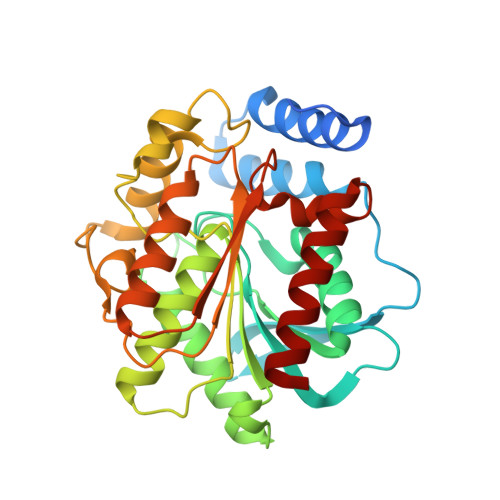Interdomain Hydrophobic Interactions Modulate the Thermostability of Microbial Esterases from the Hormone-Sensitive Lipase Family.
Li, P.Y., Chen, X.L., Ji, P., Li, C.Y., Wang, P., Zhang, Y., Xie, B.B., Qin, Q.L., Su, H.N., Zhou, B.C., Zhang, Y.Z., Zhang, X.Y.(2015) J Biological Chem 290: 11188-11198
- PubMed: 25771540
- DOI: https://doi.org/10.1074/jbc.M115.646182
- Primary Citation of Related Structures:
4XVC - PubMed Abstract:
Microbial hormone-sensitive lipases (HSLs) contain a CAP domain and a catalytic domain. However, it remains unclear how the CAP domain interacts with the catalytic domain to maintain the stability of microbial HSLs. Here, we isolated an HSL esterase, E40, from a marine sedimental metagenomic library. E40 exhibited the maximal activity at 45 °C and was quite thermolabile, with a half-life of only 2 min at 40 °C, which may be an adaptation of E40 to the permanently cold sediment environment. The structure of E40 was solved to study its thermolability. Structural analysis showed that E40 lacks the interdomain hydrophobic interactions between loop 1 of the CAP domain and α7 of the catalytic domain compared with its thermostable homologs. Mutational analysis showed that the introduction of hydrophobic residues Trp(202) and Phe(203) in α7 significantly improved E40 stability and that a further introduction of hydrophobic residues in loop 1 made E40 more thermostable because of the formation of interdomain hydrophobic interactions. Altogether, the results indicate that the absence of interdomain hydrophobic interactions between loop 1 and α7 leads to the thermolability of E40. In addition, a comparative analysis of the structures of E40 and other thermolabile and thermostable HSLs suggests that the interdomain hydrophobic interactions between loop 1 and α7 are a key element for the thermostability of microbial HSLs. Therefore, this study not only illustrates the structural element leading to the thermolability of E40 but also reveals a structural determinant for HSL thermostability.
- From the State Key Laboratory of Microbial Technology and the Marine Biotechnology Research Center, Shandong University, Jinan 250100, China.
Organizational Affiliation:

















